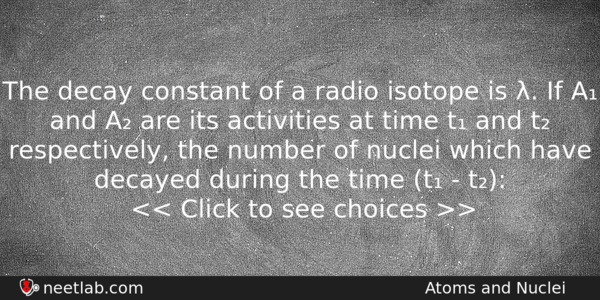| ⇦ | 
| ⇨ |
The decay constant of a radio isotope is λ. If A₁ and A₂ are its activities at time t₁ and t₂ respectively, the number of nuclei which have decayed during the time (t₁ – t₂):
Options
(a) λ (A₁ – A₂)
(b) A₁t₁ -A₂t₂
(c) A₁ – A₂
(d) (A₁ – A₂) / λ
Correct Answer:
(A₁ – A₂) / λ
Explanation:
Activity is given by A = dN/ dt = -λN
Activity at time t₁ is A₁ = – λN₁
and activity at time t₂ is A₂ = -1 N₂ as t₁ > t₂ therefore, number of atoms remained after time t₁ is less than that remained after time t₂.
That is, N₁ < N₂. number of nuclei decayed in (t₁ - t₂)
= N₂ - N₁ = (A₁ - A₂) / λ
Related Questions: - A proton and an alpha particle both enter a region of uniform magnetic field B,
- If temperature of gas increases from 27°C to 927°C, the kinetic energy will be
- In a given process on an ideal gas, dW=0 and dQ<0. Then for the gas
- If the sodium light in Young’s double slit experiment is replaced by red light
- A body is thrown upward from ground covers equal distances
Topics: Atoms and Nuclei
(136)
Subject: Physics
(2479)
Important MCQs Based on Medical Entrance Examinations To Improve Your NEET Score
- A proton and an alpha particle both enter a region of uniform magnetic field B,
- If temperature of gas increases from 27°C to 927°C, the kinetic energy will be
- In a given process on an ideal gas, dW=0 and dQ<0. Then for the gas
- If the sodium light in Young’s double slit experiment is replaced by red light
- A body is thrown upward from ground covers equal distances
Topics: Atoms and Nuclei (136)
Subject: Physics (2479)
Important MCQs Based on Medical Entrance Examinations To Improve Your NEET Score
18000+ students are using NEETLab to improve their score. What about you?
Solve Previous Year MCQs, Mock Tests, Topicwise Practice Tests, Identify Weak Topics, Formula Flash cards and much more is available in NEETLab Android App to improve your NEET score.
Share this page with your friends

Leave a Reply